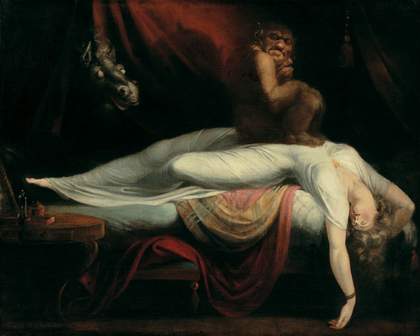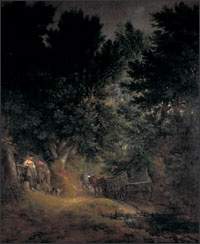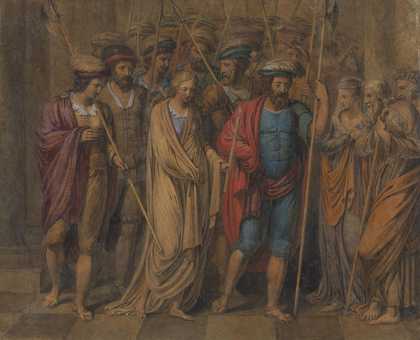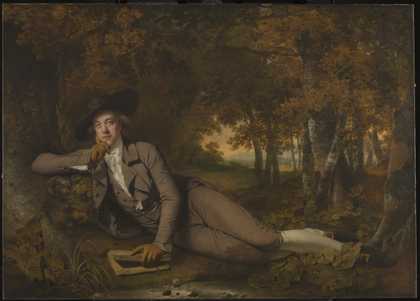
Joseph Wright of Derby
Sir Brooke Boothby (1781)
Tate
In the summer of 1783, the Derbyshire gentleman Brooke Boothby, famously pictured as the quintessential man of sensibility by Joseph Wright of Derby (fig.1), organised a Gothic pageant for the painter Henry Fuseli in the woods behind a house belonging to one Colonel St George, somewhere in England. Involving costume, elaborate stage effects, poetry (penned by the struggling Irish writer Elizabeth Ryves) and an all-singing, all-dancing finale, this midnight entertainment was intended to ‘suprize & amuse the great Wizard painter, who had no suspicion of ye scheme’.1 Boothby, Fuseli, and the poet Anna Seward all took key roles in the pageant, dressing up, delivering their lines as supplied by Ryves, taking part in the carefully plotted action in different spots in the wood. Their family and friends assumed supporting roles, sporting costumes as fairies, monsters, knights and ladies, singing and dancing, and interacting with the lead players on cue. Curious and amusing as the details of the pageant are, its significance does not lie in the mere fact of its taking place. Private theatricals were immensely popular among the well off in the later eighteenth century, and could take on elaborate forms encompassing the fantastical and medievalising imagery associated with the literary genre of Gothic Romance.2 The interest of this pageant lies, instead, in its implicating Fuseli and his art in the wider culture of the Gothic in such a complete and complex way. Combining elements of both high culture and sensationalist entertainment, the high-minded and the downright silly, and public and the personal, this piece of play-acting may help us re-situate Fuseli in relation to the shifting and necessarily uneasy territories of cultural performance and consumption of the 1770s and 1780s, when in Britain social, aesthetic and political values were being thoroughly interrogated in the face of the profoundly divisive historical trauma of the American Revolution (1775–82).
By the time of the pageant, the Swiss-born Fuseli had already established himself as a painter specialising in fantastic and strange imagery consonant with the literary Gothic. Having struggled to establish himself as a translator and illustrator in London in the later 1760s, Fuseli had attracted enough patronage from private supporters to send him to Rome, where he spent most of the 1770s at the heart of an international circle of artists developing a highly stylised, anti-academic graphic manner evocative of the excesses of Michelangelo and Mannerism.3
Settling back in London in 1779 he showed a series of works at the annual Royal Academy exhibitions, based on subjects from English literature, the Classics, and subjects of his own invention – notably the famous Nightmare exhibited in 1782 (Detroit Institute of Arts) – that had swiftly confirmed his reputation as a painter of the horrible, fantastic and perverse.4 These preoccupations were folded into his public image as a wild, anti-social eccentric, much given to foul language and daring proclamations against conformity delivered in his distinctive Swiss accent. Rumours of his indulging in opium use and eating raw pork to fuel his sickly imagination lent a pathological element to his public reputation, making him one of the best known, and certainly most controversial, artists of the day. Whether viewed as a genius or as a fraud, Fuseli’s reputation was as a kind of magician, occupied with arcane and supernatural matters. It was this idea of Fuseli as a ‘Wizard painter’ which was taken quite literally during that night in St George’s woods.
The anonymous and unpublished text describing that evening states that at the end of dinner at St George’s house, the host invited Fuseli to take a walk with him in the woods. After a while strolling among the trees, Boothby suddenly appeared, now resplendent in full medieval armour – ‘Armed at all points in complete steel’. St George ‘slunk away & left the Painter alone to the encounter, whom ye Knight accosts as a Magician, who was to aid him in feats of high adventure casting over him a Magician’s robe, & delivering to him a white wand’. What followed was a sequence of events organised according to the well-worn conventions of Gothic Romance, writings about knights and monsters, wizards and castles, derived from medieval and renaissance literature and given hugely popular new currency in the late eighteenth century Gothic novel and popular magazines.5 Boothby and Fuseli were first confronted by men dressed as knights who proclaimed that they fought in the name of ‘Urma’. Boothby got into a bit of a scuffle with one of them, forcing himself and Fuseli onwards where they came to a mausoleum. Within this structure was a skull containing a scroll explaining (in verse) that they were in the presence of the remains of an evil wizard, the aforementioned Urma, who has set a curse that only the knight and magician (Boothby and Fuseli) could break. ‘Pursuing the sound of mournful shrieks’ they travelled further on, and discovered a ‘monster’ gnawing on ‘a bleeding head’. Finally they came upon a ‘Knight and lovely lady’ in an enchanted sleep, whom Boothby pretended to waken by waving a magic sword over them. In triumph, Boothby and Fuseli entered a brightly lit glade, where they were surrounded by ‘a troop of splendid fairies, who dancing round the valorous knight & magician crown them with laurel wreathes’, singing:
Hail thee Valorous favoured Son
Now is past ye fateful hour
Thou ye magic sword has won
That bursts Enchantment’s dreaded powerHail bright Fancy’s favour’d Child
Born in Zurich’s mountains wild
Whom thy immortal Mother bore
High o’er ye Surge to Albion’s shore
The climax of the evening came when the poet Anna Seward descended from a tree dressed as’the Muse of Elegiac Verse’. The ‘fairies’ exhorted Seward to stop lamenting that most famous British victim of the American war, Major John André (hanged as a spy in October 1780 and the subject of a hugely popular poem by Seward) and instead use her literary powers to praise one immediately present, who had suffered in the war with America hardly less:
On thy much lov’d Andre’s beir
Trophies of they friendship stand
Wreaths that shall for ever bloom
Wove by thy immortal handThat Duty paid O Lady turn
From his Laurel shaded Hearse!
Nor o’er the cold insensate Urn
Waste ye music of thy verse.6
The ‘fairies’ thus implored Seward to turn to their host, St George. As a note to the account of the pageant explains, St George was invalided in the conflict, and ‘now lives with half his head shot away’:
The Knight who here requires thy lays
Like that brave youth for Britain foughtAnd wears Alas! the shining bays
Of Glory all too dearly bought
The account of this pageant provides a fascinating insight into the late eighteenth-century private theatrical and the kinds of role-playing the cultured gentry class would indulge in, in search of entertainment. It also confirms Fuseli’s connection with the politically radical and bourgeois intellectual circles of the midlands and the north-west. Boothby was known for his advanced literary tastes, while the Lichfield-based poet Seward was a pioneering poet of modern sentimental values, and both were closely connected with the provincial gentry and business class who were to provide Fuseli’s most reliable sources of support, in common with Wright of Derby (who had painted his portrait of Boothby in 1781) and George Romney (who had started his portrait of Seward the previous summer – in 1782 – and who was later to paint St George’s wife and son).7 It might also help us to think about Fuseli as an artist whose work, despite its many risible and superficial qualities, was richly involved in a historical moment wherein the status of Gothic fantasy, and the attendant issues about the nature of cultural representation, the national past, and the formation of gender identity, underwent significant transformations. Gothic Romance, in literature, in performance, and in Fuseli’s art, was emerging as a cultural form whose debased and absurd qualities were acknowledged even by its supporters. Yet it was a form which, as might be suggested by the turn of events during the pageant which could transform a tribute to the ‘Wizard painter’ into a lament for a man suffering from the consequences of Britain’s imperial troubles in a very real way, provided a means of addressing and working-through urgent social and political anxieties.
Fuseli and his art are implicated in the form of this pageant, not just because he was there, nor even just because a fantasy pageant was seen as a suitable way to pay tribute to him, but because the pageant itself was formed in part out of his imagery. The evil wizard ‘Urma’ who has cast a spell over the woods in this pageant is not to be found in any established literary source, not in any original medieval Romance, nor in the later poetic revisions of Romance convention in Spenser or Milton or James Thomson, nor even, as far as can be found out, in any contemporary Gothic novel. The character is, rather, an invention unique to Fuseli. In 1782 he had painted two pictures dealing with Urma. One, known from a mezzotint, showing a sulky-looking Urma with a knight and a lady under his enchantment (fig.2)
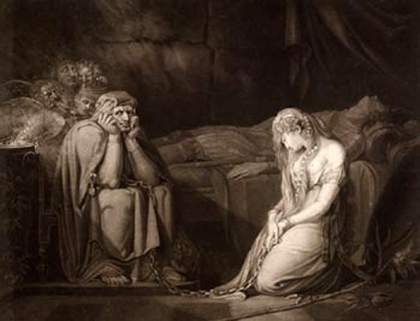
Fig.2
John Raphael Smith after Fuseli
Belisane and Percival under the Enchantment of Urma 1873
The British Museum
The second, exhibited at the Royal Academy in the Spring of 1783 (immediately prior to the pageant) showing Percival sprung to life and about to despatch Urma (fig.3). In the print and in the catalogue of the exhibition Fuseli claims that the source of his subject were the ‘Provencal Tales of Kyot’. These were identified by Wolfram Von Essenbach as the source of his Arthurian Romance, Parzival, written in the early thirteenth century and first published in 1477, a classic of early German literature.8 But, there is no documented Kyot, no real literary work authored by or even attributed to him. Instead, the source was an invention of Wolfram. And there is a further layer of deceit, for Wolfram claimed that Kyot’s text was itself a translation from an Arabic manuscript discovered in Toledo. So in claiming that the source of his ’Urma’ pictures Fuseli was in the ‘Tales of Kyot’, Fuseli was claiming to be painting a subject taken from a text which never existed which was in turn meant to be a translation of a further text, which never existed either. Still, the deceit does not end, as the character of Urma named in the images Fuseli claims to derive from Wolfram’s literary sources does not appear in Wolfram’s text. It does sound appropriately ‘Gothic’: the closest parallel in literature is, perhaps, Urganda, the good enchantress in Amadis the Gaul, one of the most famous early Romances.9 But it is not possible to securely identify a specific source for this figure; the same problem appears with the other characters in the painting.

Henry Fuseli
Percival Delivering Belisane from the Enchantment of Urma (exhibited 1783)
Tate
Writing to his patron William Roscoe in 1791, Fuseli admitted that the picture of Percival and Belisance was one of those showing: ‘Such Situations as I have Combined… Philosophical Ideas made intuitive, or Sentiment personified’.10 So the character of Belisane is one ‘Combined’ by the painter. There is a ‘Belacane’ in Wolfram’s text, but she was the lover of Percival’s father, before the hero was even born, so could hardly be taken as the model for Fuseli’s figure. There is also a ‘Belisent’ who appears in a number of English Arthurian Romances, although never as Percival’s lover. There is a bit more certainty with regard to the figure of Percival, who was a stock character in Arthurian Romance. He was the archetypal Saxon hero who became a knight without belonging to courtly culture, and who could thus stand, within Anglo-British political discourse, as a demotic, patriotic hero in opposition to the more highly cultivated notions of knighthood associated with later Norman rule. The latter represented a foreign, French heritage sometimes associated further with Scots-Jacobite tendencies, rather than a supposedly ‘native’ Anglo-German one aligned with the Hanoverian state or, among more radical political factions, the Anglo-Saxon legal and cultural heritage represented in institutions which preceded that state and which needed to be defended against it.11 Again, Fuseli would appear to be making a generic rather than specific reference, but trying to identify his sources is a frustrating business. Years later, the poet Lord Byron tried to find out the source of Fuseli’s characters for his painting Ezzelin and Meduna (1779, Soane Museum), only to be informed by the artist that these had been invented by him.12
To see why this might be a problem, or at least unusual, we can consider what pictorial genre Fuseli’s images ask to be considered within. With their dramatic action, heroically-conceived figures, historically distant settings and painterly gloomth, Fuseli’s Gothic paintings of these years invite interpretation as works in the highest pictorial mode, the Grand Manner. Considered in relation to the regulations of literary epic which provided the first points of reference for definitions of the Grand Manner in visual art, the absence of a secure literary source in these images by Fuseli presented a serious issue. Quite how far Fuseli has departed from the norms of epic composition might be made apparent by invoking Alexander Pope’s ironic ‘Receit’ (recipe) for the production of epic: ‘Take out of any old Poem, History-books, Romance, or Legend, (for instance Geffry of Monmouth or Don Belianis of Greece) those Parts of Story which afford the most Scope for long Descriptions: Put these Pieces together, and throw all the Adventures you fancy into one Tale. Then take a Hero, whom you may chuse for the Sound of his Name, and put him into the midst of these Adventures…13 Pope’s immediate target are those writers who work to formulae, rather than being truly inventive, but his point about the dangers of creating arbitrary and unmeaning characters just for effect stands. Fuseli’s protagonists are similarly given names that just ‘Sound’ right, his characters are equally formulaic, and it is in this disregard for narrative convention, and the moral instruction that was meant to be achieved through a coherent and legible story, that Fuseli can be considered as a kind of Gothic artist. Fuseli’s exclusive emphasis on a single moment of drama which can not be contextualised by reference to a larger narrative forces the viewer to attend to the formal arrangement of bodies in order to extricate any sort of content. The ‘message’ or narrative content is secondary to the experience of the image, and Fuseli’s artistic performances are about the play of fundamentally vacuous signs, rather than interior or hidden messages. The costumes and period details give a general sense of the story, so the genre is made broadly evident, but it is the emotional drama generated from the arrangement of bodies which generates more specific meanings for the viewer. The obvious signs, chains and dungeons, witches and knights, seem trivial and playful – they are merely a dressing to the event, setting up associations, but not pinning the depicted scene down to known literary precedents and contributing instead to a sense of sublime mystery. To follow Marshall Brown’s argument, the superficial signs of the Gothic are not significant for the literal content they may convey; on the contrary, it is the subjective frisson generated by the play of those signs that counts.14 The Gothic demands a way of reading that meant that the question of exemplary masculine action is almost irrelevant. The whole story cannot be known, so it is a momentary action, conveyed in a semantic vacuum, which defines the hero. According to Andrea Henderson, the Gothic represents a world ‘emptied of content’: that is, defined through the shifting processes of personal interaction and exchange that typify commercial society rather than the fixed certainties of ‘genealogy’ (the personal origins of the individual character, which in conventional narrative imagery, with its cast of established heroes, would be known to the reader).15
There would be nothing new in claiming a parallel between Fuseli’s art and the Gothic. The connection between Fuseli’s art and Gothic writing was recognised at the time, and there is a clear common ground between the critical literature responding to Fuseli’s art and to writings about Gothic Romance: there were shared questions about artistic propriety, the dangers of confounding ‘real’ and ‘fantasy’ versions of the past, the perils of creating art that addressed the ‘feminine’ imagination rather than conforming to ‘masculine’ civic values. When the Rev. Bromley sought to criticise Fuseli in his Philosophical and Critical History of the Fine Arts (1793), it was by pitching him against the enormously successful painter of historical subjects, Benjamin West. According to Bromley, where West sought out subjects from ‘real history’ and depicted them with close attention to historical details, Fuseli was a mere fantasist, and in this like the purveyors of cheap literature:
the dignity of moral instruction is degraded, whenever the pencil is employed on frivolous, whimsical, and unmeaning subjects. On this head, it is to be feared, there will ever be too much cause for complaint, because there will ever be persons incapable of solidity, although very capable of executing this art with power. Strength of understanding, and ability in art or science, are very different things; they are derived from different sources; and they are perfectly independent of each other. The one can no more be instrumental to the communication of the other, than either can communicate temper or disposition. The finest art in the world may therefore be combined with the lightest and most superficial mind. Books are written of a light and fantastic nature by those who cannot write otherwise, and yet will write something. And so it is with painting: the mind of the artist can but give such subjects as are consentaneous to its turn. The night-mare, little red riding hood, the shepherd’s dream, or any dream that is not marked in authentic history as combined with the important dispensations of Providence, and many other pieces of a visionary and fanciful nature, are speculations of as exalted a stretch in the contemplation of such a mind as the finest lessons that ever were drawn from religion, or morals, or useful history. And yet the painter, who should employ his time on such subjects, would certainly amuse the intelligent no more than the man who should make those subjects the topics of a serious discourse. But what good has the world, or what honour has the art, at any time derived from such light and fantastic speculations? If it be right to follow Nature, there is nothing of her here, all that is presented to us is a reverie of the brain. If it be allowable to cultivate fancy; yet the fancy, which has little or nothing of Nature in it’s composition, becomes ridiculous. A man may carry the flights of imagination, even within the walks of the chasest art or science, till they become mere waking dreams, as wild as the conceits of a madman.16
And when Gillray sought to satirise the vogue for fantasy literature in 1802, by which time the fashion for the Gothic had reached fever pitch with a new kind of cheap and lurid paperback novel, he featured the telling detail of a painting on the wall that with its athletic hero in a skin tight costume and limp maiden would immediately be identified as by Fuseli, or at least, ‘Fuselian’ (fig.4).
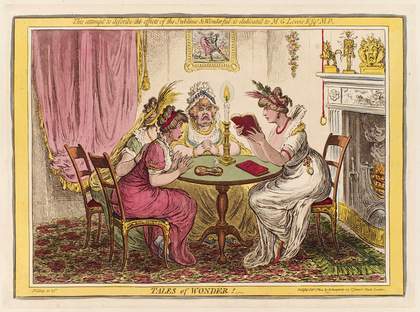
Fig.4
James Gillray
Tales of Wonder published 1802
The British Museum
We are in a position, now, to return to such analogies with a sharpened historical sense. The history of Gothic literature could once be written as if there was an unbroken tradition originating in Richard Hurd’s Letters on Chivalry and Romance of 1762, which established a relativist framework for the appreciation of early literature which largely disregarded the conventions of classical literary thought, and Horace Walpole’s Castle of Otranto of 1764, famously the first modern Gothic novel. The long pause before the massive acceleration of novels and short stories on Gothic themes in the later 1770s remained unexplained. More recently, a number of commentators including, notably, Harriet Guest and E.J. Clery, have instead drawn attention to the discontinuities in late eighteenth-century Gothic writing, in particular this pause between Walpole and Hurd and the resurgence of Gothic Romance in the later 1770s.17 This resurgence can now be interpreted in relation to the radicalised political situation of the latter era, and most pertinently for the present study can be given a context in the increasingly prevalent concerns about the ostensible ineffectiveness of modern men and the feminisation of culture, and thus the perceived alienation of an heroic past claimed, on different terms, by the monarchy and establishment, and the political opposition. In the realm of social criticism, the 1770s saw the emergence of a powerful historicising concern with the failings of modern masculinity, which generated persuasive ideals of heroic manhood located especially in the medieval past. In imaginative art, it was this historicising concern to find better models of manhood that underpinned the influential imagery of John Hamilton Mortimer in the 1770s, who looked to literature and to history for source matter, and who invented a more uneasy imagery of criminal ‘banditti’ resonant in a general sense of the world of Gothic Romance. His images of a kind of masculine heroism that was both tremendously appealing and criminal registers a recognition that the purest standards of martial heroism were in truth inappropriate to a modern, feminised consumer society, and his Sir Arthegal, the Knight of Justice, with Talus, the Iron Man (taken from Spenser’s Faerue Queene) offered a vision of rugged, uncompromising martial masculinity far distant from what was being perceived in the late 1770s as an overly effete and ineffective British army (fig. 5).18 Mortimer’s untimely death in 1779 stopped his developing the potential of such imagery further, but his pictures form an important precedent for Fuseli’s Gothic scenes and that artist’s dynamic conception of the masculine hero.
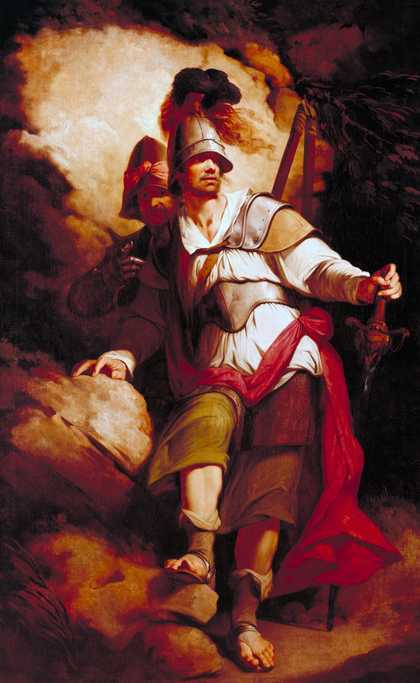
John Hamilton Mortimer
Sir Arthegal, the Knight of Justice, with Talus, the Iron Man (from Spenser’s ‘Faerie Queene’) (exhibited 1778)
Tate
Mortimer’s work from the 1770s indicates how the Gothic past supplied a powerful source of images of virtue and heroism that could be set against the vices that seemed to dominate in political and imperial affairs (with corruption in the colonial East India Company and the unrest and war in America) and the apparent dissolution of gender distinctions in the social sphere (manifest in the purported prevalence of effeminate Macaronis in fashionable life).19 But how that past was imagined, and how far the issue was one of historical rather than imaginative representation, opened up the contestation of political power between the state establishment and its adherents, and more stridently middle-class and radical tendencies. Was the romantic Gothic past to be a source only for thrillingly fantastic images of sexual affirmation in an era of gender doubt, or did it provide precedents of gender certainty necessarily grounded in a conservative sense of national heritage? Were the institutions and traditions of the English establishment rooted in a truthful medieval history, and if so did they sustain or counter the claims to political and moral authority of the Hanoverian state (with its much more recent origins)? And aside from these questions, reclaiming the Gothic as a tool for either conservative or progressive political expression was no easy thing. Earlier eighteenth-century commentaries on Gothic Romance had been quite consistent in claiming that their appeal had been effectively demolished by Cervantes in his novel Don Quixote, well known in England in translation.20 The novel, the story of a Spanish gentleman who tries to live according to the virtues of the Gothic Romances he consumes obsessively, but who can, in the modern age, appear only deluded, was considered as having definitively rendered the ideals of the medieval knight as absurd. William Warburton had set Cervantes against the tradition of debased Romance in his preface to a 1742 translation of Don Quixote, a point elaborated by Tobias Smollett in his preface to his novel Roderick Random (1748), where he famously claimed that Cervantes had effectively revealed the fundamentally anachronistic absurdity of Romance, which could now be superseded by the modern novel: ‘Cervantes, by an inimitable piece of ridicule, reformed the taste of mankind, representing chivalry in the right point of view, and converting Romance to purposes far more useful and entertaining, by making it assume the sock [ploughshare, ie. go to work], and point out the follies of ordinary life’.21 But, during the 1760s, and particularly through the 1770s and 1780s, Don Quixote’s heroic character and the reputation of Romance were restored. In part this was the work of the new, historicising literary criticism. Influentially, Richard Hurd had aligned Homer and Gothic Romance, suggesting that while there was no doubt a qualitative difference between them, they were, fundamentally, the same literary creature, and if the historically-specific terms on which they operated as literature were acknowledged, they could equally be appreciated. He perceived in medieval Romance the same primitive appeal as was to be found in (the almost universally acclaimed) Homer: both were the products of a feudal culture ‘whose turbulent genius breathed nothing but war, and was fierce and military even in its amusements’.22 With such comparisons being made, the opposition between exemplary history and debased popular forms proposed by traditional historiography might then be collapsed. If Homer and medieval fantasies are equally elevated, they may be equally elevating to their readers: ‘To read of kings, generals and statesmen; of wars, battles, and the intrigues of politics; is delightful to the bulk of mankind, for the same reasons that Romances were once so bewitching: because they are above their level, and therefore answer the same purposes with giants and enchanted castles’.23 The value of Gothic Romance was elaborated most fully by Clara Reeve, in her lengthy Progress of Romance (1785). An entrenched Old Whig, Reeve sought to revise the decadent, aristocratic Gothic of Horace Walpole and stressed instead the instructive value of Romance literature in the (self-willed) formation of the virtuous citizen.24 While commentators had traditionally cast ‘real’ history and Romance in opposition, the Progress of Romance posits that Romance and epic can be equated. There she has her mouthpiece Euphrasia state that Romance is ’an Heroic fable, – a fabulous Story of such actions as are commonly ascribed to heroes, or men of extraordinary courage and abilities. – Or if you would allow it, I would say an Epic in prose’. Reeve claims that history, Romance and epics have, in fact, a single origin, in the ‘traditional stories of their most eminent persons, that is of their Heroes’. Therefore Homer’s heroes and Sinbad are the same. Indeed, inverting Smollett’s arguments, Reeve argues that Romances are better than modern novels by providing in their heroes’patterns of courage, truth, generosity’.25
It is here that Gothic Romance connects with the cult of sensibility, the new emphasis on the value and virtues of personal feelings over social convention, focused on the writings of Rousseau (which Boothby had made known he had promoted – he is shown holding a manuscript by Rousseau in Wright’s portrait, fig.1). Anticipating this tendency, Seward (who was to become the pre-eminent poet of sensibility) had recommended Rousseau to the young men of the early 1760s, when his writings were first becoming known in England, because:
Among the modern youth, satiric contempt of tender attachment has succeeded to the enamoured Quixotism of former time. With that sex, since chastity, unfortunately for it, is not the point of honour, no guard can be substituted for masculine purity, so likely to preserve it from the fatal effects of debauched habits, as a fervent and constant passion for a refined and amiable woman.26
The Quixotic attendance to outmoded styles of chivalry could, then, offer some kind of release from the corruption of modern life, even if this meant becoming absurd. Romance could now even offer models of masculine virtue equivalent to the Classical heroes recommended by traditional élite education and inherited cultural values. As the novelist Richard Graves noted, somewhat wryly, in his Spiritual Quixote (1773):
Though the profession of chivalry has been exhibited to us by Cervantes, as an object of ridicule; we must not imagine that it was in itself, and in its original, really ridiculous. Knight-errantry took its rise from true heroism, and the most generous principles of honour and public spirit. The most celebrated heroes of antiquity were in reality knights-errant: who wandered about, to subdue monsters or to deliver men from oppression; to protect the innocent, or chastise the insolent; and, in short, to redress those grievances which were not sufficiently provided against by established laws, in the ruder ages of the world.27
Such arguments were to become hotly contested in the years following the American war, which saw the emergence of what James Watts calls the loyalist Gothic Romance, where the political associations of the medieval are brought to the fore and the distinction between imagination and historical truth re-drawn.28 As early as 1771, when David Garrick revived Gilbert West’s The Institution of the Order of the Garter (1742), George III’s reclamation of a revised version of the medieval past to counter the accounts of a native, Anglo-Saxon political heritage favoured by the political opposition was taking form.29 In the historical novels of the 1780s the chivalric past was presented as the locus of certainty and virtue against the corruption of modernity, but not on the grounds that such a past held within it the precedents of political institutions that ensured personal liberties (that is, the theory of ancient constitutionalism employed by opponents to the monarchy), but because it represented a world of social hierarchy and of sharpened social distinctions. Equally, the loyalist version of the Gothic sought to counter the libertarian aspect of fantasy literature, denying the frivolous and playful aspects of the form.
The purging of historical romance of the oppositional associations forged in mid-century patriotism and maintained in the Wilkesite agitation and ancient constitutionalism of the 1760s and 1770s was not inevitable or uncontested. Active counter-claims to loyalist interpretations of the national past were made with the radical antiquarianism of Edward Williams, Joseph Ritson and in the circles around the publisher Joseph Johnson.30 At the end of the 1770s William Blake could project a series of designs representing scenes from ancient and medieval history from a radical political perspective. Such radical associations continued into the era beyond the loss of America, with, for instance, William Godwin’s Imogen: A Pastoral Romance, from the Ancient British (1784) which drew on the resources of national history in the creation of a determinedly anti-imperialist and anti-aristocratic literary work. The image of Ancient Briton persisted in the imagery of Blake as a symbol of ancient liberties and a focus for resistance to Hanoverian hegemony, and in a much more public way, John Boydell’s commissions for large-scale medieval subjects from John Opie and James Northcote in the later 1780s should, perhaps, be interpreted as a counter to the aristocratic and royal patronage of large-scale historical narratives that were becoming evident through the 1780s (notably George III’s commissions for medieval subjects by Benjamin West). The dominant presence of these works on the walls of the Royal Academy exhibition in 1787 signalled the abiding cultural authority of the City against the court and the possibility of drawing anti-monarchical lessons from history, even as the political authority of the monarchy was becoming entrenched and the more historically immediate traumas of the loss of America being swept under the carpet in favour of an intensive identification with a chivalric past. When Boydell presented these and other works to the Corporation of London in 1794 he took the opportunity to elaborate on the demotic patriotism that had motivated their production.31
Still, the taste for Gothic Romance apparent among Boothby’s circle and the Lichfield literary set may seem wilful, even as it corresponds to the radical political tendencies of this group and their adherence to the values of sensibility. It amounted to, in effect, a rejection of the ‘middle state’ valorized by temperate versions of civic discourse since the early eighteenth century and revitalised in the 1780s and 1790s as fundamental to a middle-class social identity, a temperance which we might expect to be claimed by such advocates of sentimentality as were in evidence in Col. St George’s back garden.32 The influential anti-expansionist critique of heroism contained in Thomas Gordon’s ’Essay on Heroes’ in Cato’s Letters had concluded, after all, by proposing that a better model of modern manhood lay in the bumbling but ironically detached figure of Sancho rather than the ludicrously questing and conquesting Don Quixote: ‘I will conclude with wishing, that all nations learn the wisdom of the prudent Sancho, who, when the hero his master madly attacked the wind-mills and the lions, stood at a safe distance in a whole skin. If their governing Don Quixotes will fight, right or wrong, let them fight by themselves, and not sit at home and wantonly sacrifice their people against wind-mills and fulling-mills’.33 And an imaginary dialogue between Robinson Crusoe and Amadis the Gaul – that is, between the representative characters of the modern ‘realistic’ novel and the Romance – published in 1782 draws out the imperialist connotations of Romance: ‘As for the crusade heroes, those knight-martyrs, or whatever you please to call them, they had much better have respited their valour to defend their own respective countries, than to have waged an unprovoked war with people who never injured them’.34 Given what we know was the anti-imperialist stance of the social circle represented at Boothby’s pageant, it may be surprising that Romance could have such appeal, even to the extent of providing an appropriate vehicle for a tribute to a wounded friend.35
There may be some explanation provided with that disabled friend who played host to Boothby’s pageant. The ‘Col. St George’ who hosted the event was Richard St George Marsergh St George, a member of the Anglo-Irish landed gentry. Born Richard St George Mansergh, he assumed the additional ‘St George’ on inheriting property from his maternal uncle, Richard Mansergh St George. This was in 1771 while he was a student at Trinity College, Cambridge. Having been previously a student at Temple Bar, his education was thus the stock preparation for a member of the Anglo-Irish establishment and he dutifully went into the British army. His military career had begun as an Ensign in the 4th Regiment of Foot in 1776, although he transferred to the 52nd Regiment of Foot within a year, first as a volunteer, and subsequently purchasing a lieutenancy.36 Before leaving for America, he had himself painted in a full-length portrait by Thomas Gainsborough in the uniform of the 4th (fig.6).
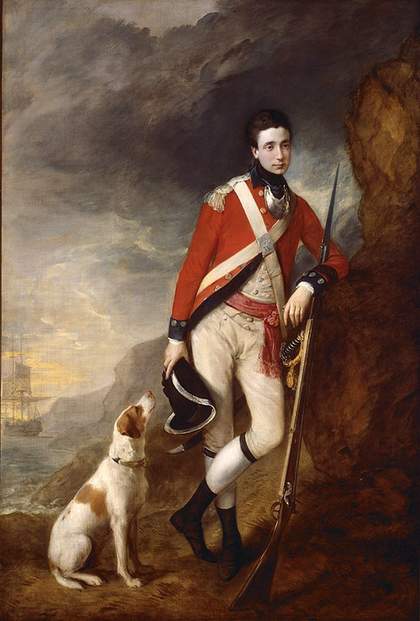
Fig.6
Thomas Gainsborough
An Officer of the 4th Regiment of Foot 1776–80
National Gallery of Victoria, Melbourne, Australia
This extraordinary portrait presents St George as the epitome of the man of feeling, leaning mournfully within a coastal scene as the ship that will take him to the unfortunate war across the Atlantic sets sail, and his dog looks up at his master pathetically.37 The painting only awkwardly combines the potentially conflicting identities of the sitter as military man and person of sensibility. It was as a lieutenant in the 52nd that St George received the injury referred to in the account of Brooke Boothby’s pageant. In the opening volleys at the battle of Germantown on 4 October 1777, St George was shot in the head, taken from the field and trepanned, leaving him with a large hole in the side of his skull. The wound was covered with a disfiguring silver plate, habitually covered by St George with a black silk cap, and never healed. In her ‘Epistle to Colonel St George, Written April 1783’ Anna Seward noted that ‘He now lives with a considerable part of his head shot away, and though feeble, emaciated, and in almost constant pain, his imagination and his virtues have lost nothing of their vigour’.38 Unable to face the cold and damp conditions of Ireland or England, St George regularly took extended tours to Europe, neglecting his estates until his eventual return to Ireland in the 1790s.
We know rather more about St George than we might because a fellow officer in the 52nd, Martin Hunter, left an extensive memoir, and the dramatic circumstances of his death in 1798 prompted biographical reminiscences on the part of a number of acquaintances. What these testify to was a man who, like Don Quixote, was an obsessive reader of Romances, to the point of trying to live like a hero of chivalry. Hunter’s account claims that that St George ‘was quite military mad’ and was followed by a Sancho Panza-like Irish servant who ‘copied his master in everything … He wore one of his master’s old regimental jackets, a set of American accoutrements, a long rifle and sword, with a brace of horse pistols’. In battle, he became entirely reckless: ‘On a shot being fired at any of the advanced posts, master and man set off immediately… I often thought that St George wished to be wounded, as he frequently said, “It is very extraordinary that I don’t get a clink, for I am certain I go as much in the way of it as anybody”.’39 Tellingly, Hunter seems to suggests that St George was more interested in being wounded, than doing the wounding, a tendency not wholly compatible with military duty, perhaps, but in keeping with his Quixotism.
The idea of St George as a Quixotic figure was consolidated after he was murdered by Irish rebels on his estate in Cork in February 1798. Responding to news of his death, Anna Seward even claimed that he must have been the model for the chivalric character of Orlando Falkland in Godwin’s novel Caleb Williams, ‘so exactly do we find the portrait of St George’s person, genius, virtues, and singularities, in the description of Falkland’.40 A number of newspaper reports claimed that his head injury was the result of being ‘scalped by the Savages in North America’ which rather than being a record of fact seems mainly to have been an opportunity to note that he ‘escaped with life, which is mercy more than is experienced from the barbarians of this country’, thus damning the rebellious Irish as the most savage of ‘savages’.41 These reports also assert that he was’a Gentleman of the most accomplished and amiable manners, and a soldier of the highest character and most undaunted courage’.42 An obituary writer apparently acquainted with St George stated that ‘his distinguishing trait, and what gave something of an eccentric cast to his conduct throughout life, was Romance … his whole deportment and style of acting seemed formed upon the ideas of chivalresque ages’, that this romantic patriotism formed his motivation both for joining the army, and his activities as an amateur artist, where ‘his constant subjects were knights, halls, battlements, feats of arms, with store of ladies, &c &c’.43
St George’s use of Gothic themes as a means of responding to contemporary realities found expression following the death of his wife in the early 1790s. He then wrote to Fuseli (the only evidence other than the account of the pageant linking the two) asking him to create a rather mysterious allegorical picture that would be hidden away until his own death, when it would be discovered by his sons, itself a sort of Gothic plot-line. That painting it seems was never created, but he did commission a highly singular portrait from Hugh Douglas Hamilton, which Fintan Cullen has interpreted as an expression of specifically Anglo-Irish Protestant Gothic melancholy, a response to the current political troubles in which St George was to lose his life (fig.7).44
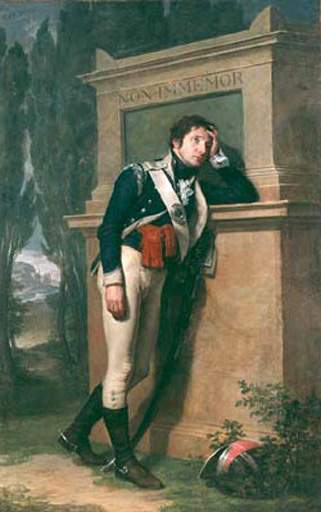
Fig.7
Hugh Douglas Hamilton
Richard St George Mansergh St George
National Gallery of Ireland
More generally, it is a depiction of the modern man as a dreamer, as disengaged from the world even when he is in uniform; arguably, it is an image of the emotional and sometimes physical masochism that has been argued as a defining feature of modern masculinity.45 Most of all, it suggests, like Gainsborough’s earlier portrait (fig.6) a contradictory, conflicted figure: at once martial and melancholy, a man of public duty and of private feelings, both effete and manly. In his cultivated tastes and his active patronage of literature and art St George conformed to the image of the modern masculine gentility, as did, perhaps, his association with literary and artistic circles of liberal and even radical political persuasions. But he was also a soldier, and had been committed to service during a bloody war that many people in Britain thought was misguided, and which seemed more like a fratricidal civil conflict than a noble struggle.46 St George’s passionate pursuit of Gothic Romance offered, perhaps, some means of establishing a form of cohesive identity in the face of these conflicting pressures, not despite but because of the fact that it was necessarily absurd and even self-destructive and even though, as a member of the Anglo-Irish gentry perilously placed between Irish and British society but belonging fully to neither, it could only accentuate his outsider status. Thus his being described as a Quixotic eccentric registers not only his personal disposition, but the contradictions arising from the encounter between outmoded value systems (of chivalry, even of virtue itself) and shifting historical realities (the new, unregulated cultural marketplace destined to cultivate ‘feminine’ passions and tastes, the derailing of Britain’s imperial project).
In Foucault’s archaeology of the human sciences, Cervantes’s novel is pinpointed as marking a major historical boundary, between a world in which the relationship between words and things, between representation and reality, is understood as natural and unproblematic, to the modern world which recognises language as an arbitrary system. Quixote marks the emergence of modernity because in him ‘we see the cruel reason of identities and differences make endless sport of signs and similitudes’.47 If Quixote marks a boundary, it is a boundary that comes forcibly into play again in the Quixotic tendencies within late eighteenth-century Gothic Romance, considered as a literary and artistic genre constituted by the tense interaction between inherited cultural and historical values, and a marketplace witnessing the ascendance of bourgeois values and an increasingly efficacious role for anonymous’popular’ forces (that is, the mass audience for art and literature). One consequence of this interaction, forcing a form of resolution onto the unstable relationship between inherited value and formless market, was the hardened definition of sexual identity as rooted in biology rather than social performance.48 From this perspective, Fuseli’s Quixotic Gothic heroes may assume an archetypal status, making visible an essentially playful and knowing understanding of identity based around a forceful, but also fanciful, stereotyping of the sexual body. Their dynamism and stylisation points forward in history, not just because these traits were to reappear in popular graphic art in later ages, but because they point to the stark essentialising of the gendered body that emerged with modernity. Within the realm of imaginative painting the ambition of Fuseli’s Gothic art is parallel to that apparent in medicine and in speculative science in the same period: to identify the essential difference between men and women in terms of their physicality. One crucial branch of this project was physiognomy, the pseudo-science involving the interpretation of social character on the basis of physical signs; the leading practitioner of this new pseudo-science was Johann Casper Lavater, an old college friend of Fuseli, for whom, in the late 1770s, he provided a series of drawings to illustrate a new translation of his essays on physiognomy. Included among them is a pair of hands; the male full of energy and vigorously foreshortened, the female limp and lifeless and flat.49 This is, in essence, a gendered relationship that we find throughout Fuseli’s art: the clichés of Fuseli’s Gothic Romance are the emerging clichés of sexual difference. Thus a masculine ideal remains in Fuseli’s work, but one which is expressed in the physical form of his characters rather than the narratives they inhabit: as with the Gothic, a sense of ‘realness’ is recovered not through reference to the social and familial origins of the individual character, which, as these are invented characters, we cannot know with certainty, but to the immediate physicality of their bodies. In the words of Harriet Guest: ‘In the feminised territory of Gothic fantasy, as in the feminised discourses of political embourgeoisification, a more immediately physical manliness is privileged in the place of the chaste masculine definition of the discourses of public power’.50 Hence the sharp gendered dichotomisation of visual form in Fuseli’s imagery, where all the heroes are supermen, with elongated limbs, pronounced muscles, armour and absurdly phallic weaponry, and all the young women are fleshy and curvaceous, caricatured signs of lifeless or soft femininity. The figures in the Perceval delivering Belisane, the old hag, the beautiful young woman, and the muscular hero, are ciphers expressing a schematic differentiation of sexual identity, mimicking the certainties of genealogical notions of identity and rendering those certainties the source of mystery. Such a schematic distinction between and within the sexes was an operational feature of Lavatar’s physiognomic system; like physiognomic theory, Fuseli’s pictures seemed to offer simple, visible signs for reading sexual status in an era of shifting identities. But this stark differentiation of visual form was equally open to the accusation that it represented a kind of absurd caricature, and removed the body from the schema of ethical value. Much as St George’s pursuit of chivalric Romance could be described as only eccentric or foolish, even foolhardy, so Fuseli’s assertion of emphatic physical difference could be criticised for its absurdly schematic and artificial qualities. Thus Benjamin Robert Haydon’s observations that ‘The Engines in Fuseli’s Mind are Blasphemy, Lechery, and Blood. His women are all whores, and men all banditti’ give voice to the moral vacuity of Fuseli’s art, the sense that his men demonstrate their manliness, and his women their femininity, without regard to moral quality.51 The very rigour of the painter’s differentiation of gendered physical forms marks, from this perspective, an anxiety about the potential for the collapse of moral value in a capitalist society, a society in which, as its critics would claim, all men are made thieves or brutes and all women forced to sell their bodies. Fuseli’s pictures are thus contributions to the forceful clarification of gendered bodily types in the late eighteenth century, that acted as a form of compensation for the perceived lack of clarity in the gendering of social roles that was developing rapidly from mid-century, and which the imperial and political troubles of the 1770s and 1780s seemed to bring to crisis point. But they are also the products of the commercialisation of culture that commented on the effects of commerce on personal identity.
In this latter respect, Fuseli’s fantasy art intimates a deregulation of the ideal of the artist as an exclusively masculine cultural agent. As E. J. Clery has argued, the ‘irrational plots and blatant appeal to the passions’ of the Gothic caused it to be: ‘classed among the corrupting agencies of feminine luxury, intimately, physically identified with the reading subject constructed as feminine’.52 It should not be difficult to see how Fuseli’s art could be classified in the same way, and Gillray’s Tales of Wonder, (fig.4) must suggest as much. Fuseli’s art was thus positioned at the crux of the issue of artistic authority and authenticity and at a point of slippage between masculine virtue and its others, whether ‘feminine’ consumerism or a kind of vicious masculine heroism. The pageant of 1783, and the involvement of St George, suggests how Fuseli can productively be considered as a Gothic artist, not just in the sense that he illustrated such themes, nor simply by way of a general analogy that would compare his art with that of the writers of Gothic literature. Rather Fuseli’s art occupies the same productive but unstable critical space as the Gothic, where the distinction between art and exploitation, high and low culture, public virtue and private vice, are conflated, confused and confounded, and the attempt to re-assert such certainties leads seemingly inevitably to the brutal stereotyping which was to be a key element in the ascendance of bourgeois social conformity.

